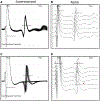Neuromuscular junction transmission failure in aging and sarcopenia: The nexus of the neurological and muscular systems
- PMID: 37270145
- PMCID: PMC10847753
- DOI: 10.1016/j.arr.2023.101966
Neuromuscular junction transmission failure in aging and sarcopenia: The nexus of the neurological and muscular systems
Abstract
Sarcopenia, or age-related decline in muscle form and function, exerts high personal, societal, and economic burdens when untreated. Integrity and function of the neuromuscular junction (NMJ), as the nexus between the nervous and muscular systems, is critical for input and dependable neural control of muscle force generation. As such, the NMJ has long been a site of keen interest in the context of skeletal muscle function deficits during aging and in the context of sarcopenia. Historically, changes of NMJ morphology during aging have been investigated extensively but primarily in aged rodent models. Aged rodents have consistently shown features of NMJ endplate fragmentation and denervation. Yet, the presence of NMJ changes in older humans remains controversial, and conflicting findings have been reported. This review article describes the physiological processes involved in NMJ transmission, discusses the evidence that supports NMJ transmission failure as a possible contributor to sarcopenia, and speculates on the potential of targeting these defects for therapeutic development. The technical approaches that are available for assessment of NMJ transmission, whether each approach has been applied in the context of aging and sarcopenia, and the associated findings are summarized. Like morphological studies, age-related NMJ transmission deficits have primarily been studied in rodents. In preclinical studies, isolated synaptic electrophysiology recordings of endplate currents or potentials have been mostly used, and paradoxically, have shown enhancement, rather than failure, with aging. Yet, in vivo assessment of single muscle fiber action potential generation using single fiber electromyography and nerve-stimulated muscle force measurements show evidence of NMJ failure in aged mice and rats. Together these findings suggest that endplate response enhancement may be a compensatory response to post-synaptic mechanisms of NMJ transmission failure in aged rodents. Possible, but underexplored, mechanisms of this failure are discussed including the simplification of post-synaptic folding and altered voltage-gated sodium channel clustering or function. In humans, there is limited clinical data that has selectively investigated single synaptic function in the context of aging. If sarcopenic older adults turn out to exhibit notable impairments in NMJ transmission (this has yet to be examined but based on available evidence appears to be plausible) then these NMJ transmission defects present a well-defined biological mechanism and offer a well-defined pathway for clinical implementation. Investigation of small molecules that are currently available clinically or being testing clinically in other disorders may provide a rapid route for development of interventions for older adults impacted by sarcopenia.
Keywords: Dynapenia; Mobility; Muscle weakness; Older adults; Physical function; Skeletal muscle function deficits.
Copyright © 2023 Elsevier B.V. All rights reserved.
Conflict of interest statement
Declaration of Competing Interest In the past 5 years, W. David Arnold has received research funding from NIH, NMD Pharma, and Avidity Biosciences. In the past 5 years, W. David Arnold has received consulting fees from Amplo Biosciences, NMD Pharma, Avidity Biosciences, Dyne Therapeutics, Novartis, La Hoffmann Roche, Genentech, Design Therapeutics, Cadent Therapeutics, and Catalyst Pharmaceuticals. In the past 5 years, Brian Clark has received research funding from the NIH, NMD Pharma, Astellas Pharma Global Development, Inc., and RTI Health Solutions for contracted studies that involved aging and muscle related research. In the past 5-years, Brian Clark has received consulting fees from Regeneron Pharmaceuticals and the Gerson Lehrman Group for consultation specific to age-related muscle weakness. Brian Clark is a co-founder with equity of OsteoDx Inc.
Figures





References
-
- (NCHS), N.C.f.H.S., Health, United States, 2018, N.C.f.H. Statistics, Editor. 2018: Hyattsville, MD.
-
- A.H.C.o.T.A.S.I.G.o.S.F EMG, Gilchrist JM, 1992. Single fiber EMG reference values: a collaborative effort. Muscle Nerve 15 (2), 151–161. - PubMed
-
- Akune T, et al., 2014. Incidence of certified need of care in the long-term care insurance system and its risk factors in the elderly of Japanese population-based cohorts: the ROAD study. Geriatr. Gerontol. Int 14 (3), 695–701. - PubMed
-
- Allen MD, et al., 2015. Increased neuromuscular transmission instability and motor unit remodelling with diabetic neuropathy as assessed using novel near fibre motor unit potential parameters. Clin. Neurophysiol. 126 (4), 794–802. - PubMed
Publication types
MeSH terms
Grants and funding
LinkOut - more resources
Full Text Sources
Research Materials

